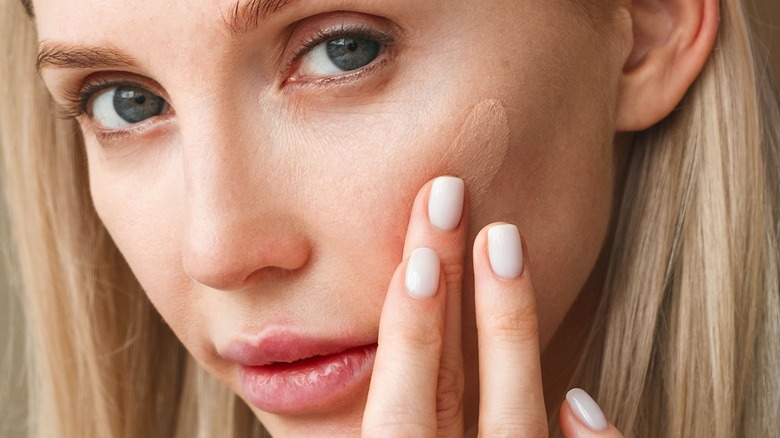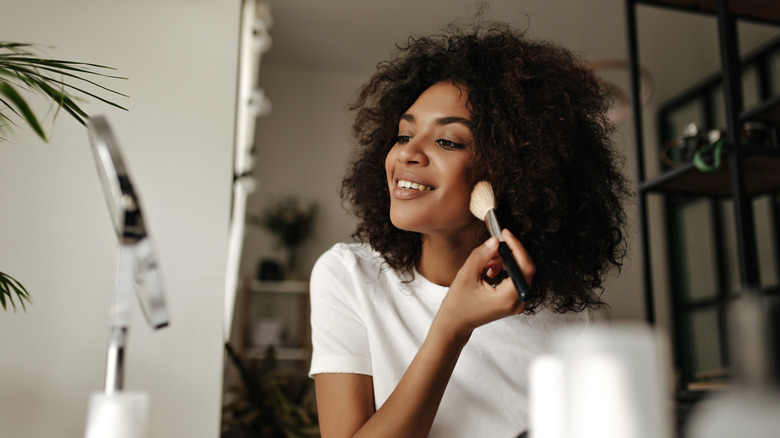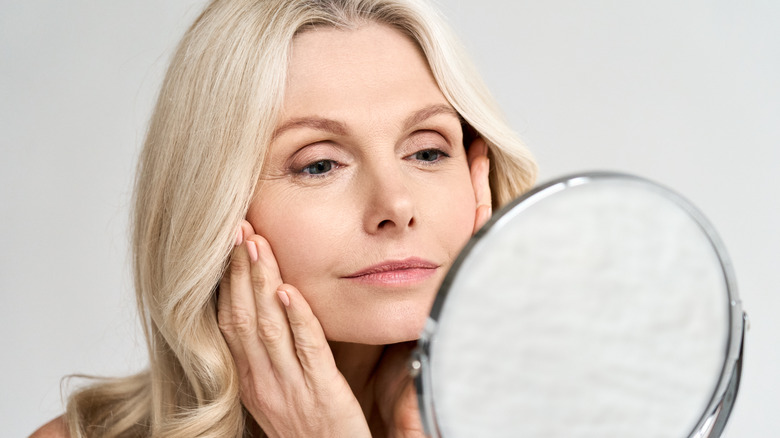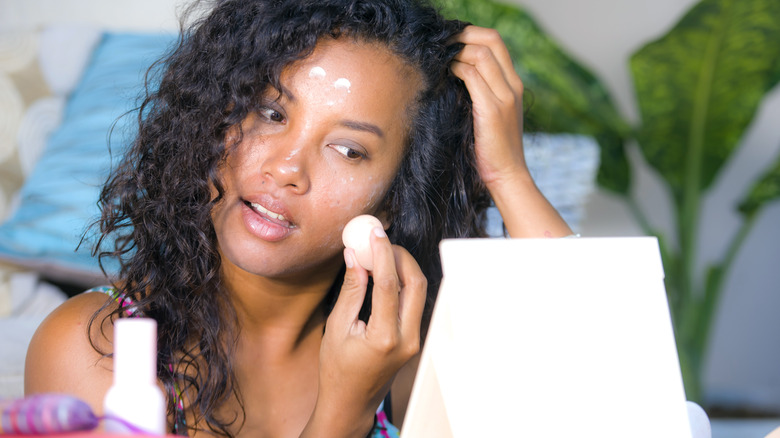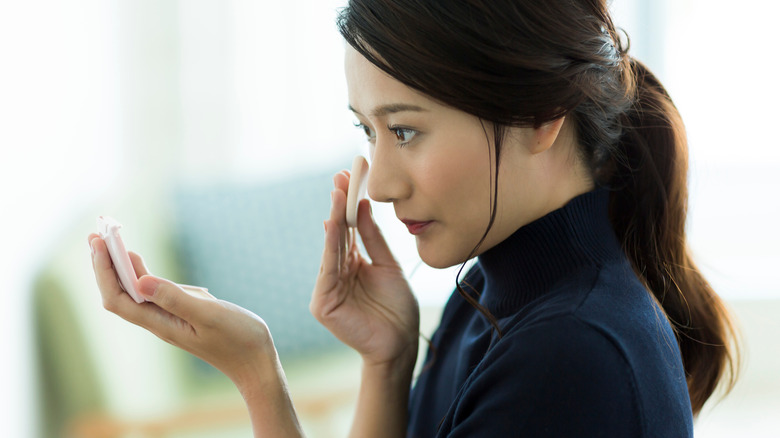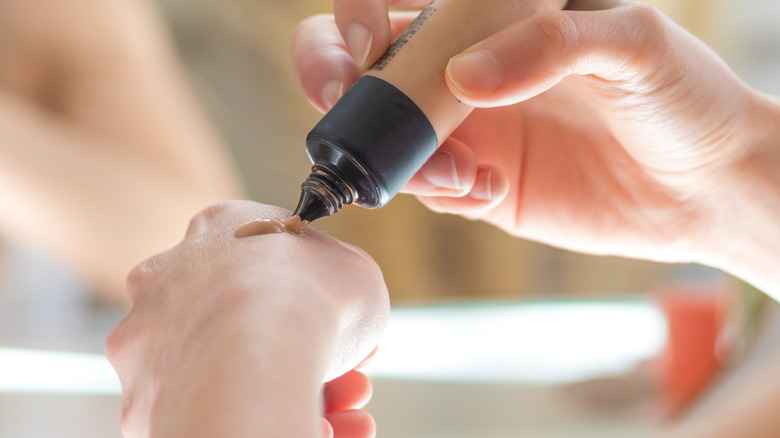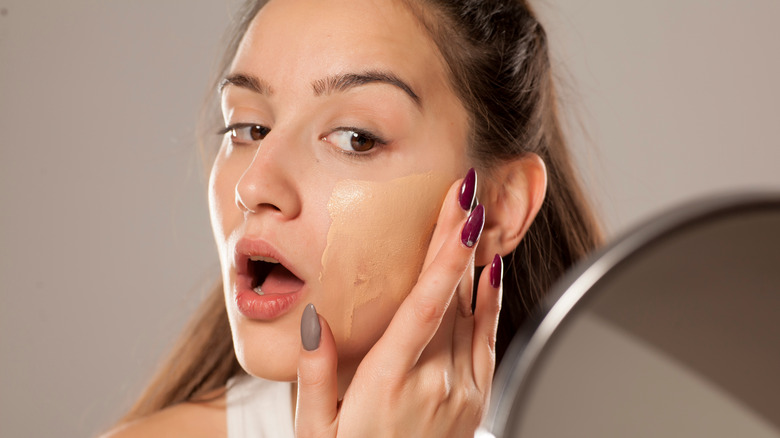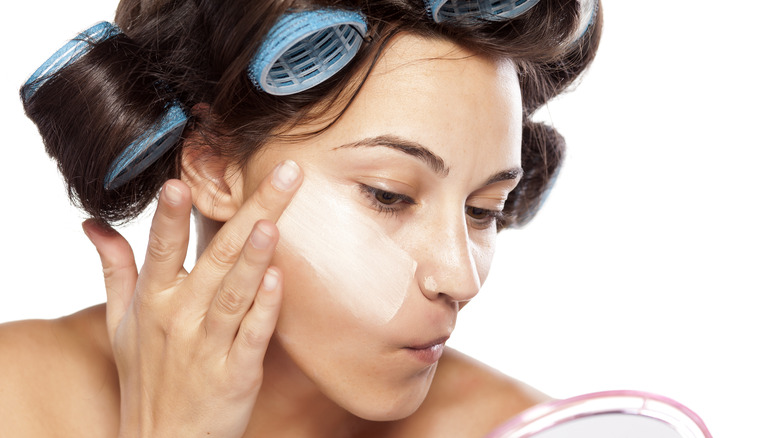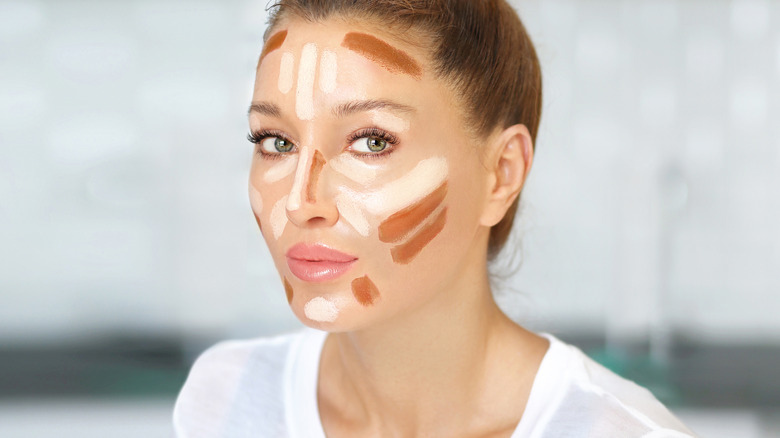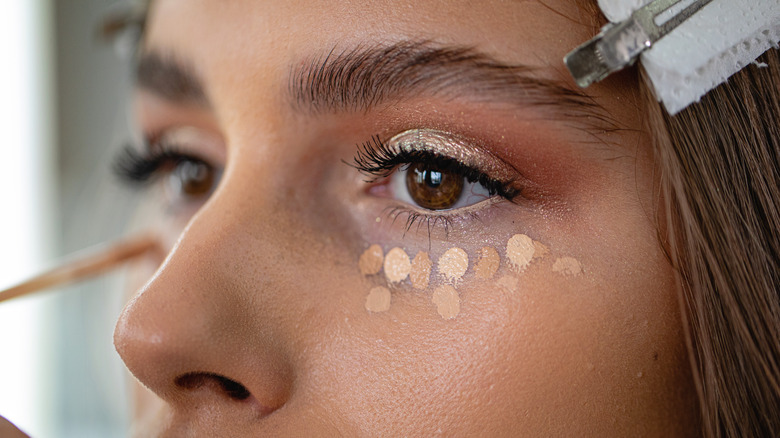Foundation Mistakes That Make You Look Older
Makeup is supposed to elevate your natural beauty. When worn correctly, it helps draw positive attention to all your best qualities. Makeup becomes an issue if you don't know how to apply your foundation properly. Wearing foundation in all the wrong ways will only make you look older than you are.
When your foundation is on point, it serves as an incredible baseline for the rest of your look. That includes your blush, bronzer, eyeliner, mascara, lipstick, and more. When your full makeup routine comes together flawlessly, it instantly raises your confidence levels because you become fully aware of how amazing you look. When your foundation isn't providing a solid base for the rest of your cosmetics, it's downhill from there.
As long as you're taking note of the ingredients incorporated in the brands you choose and you're being conscious of how you're handling the application process, the right foundation can be life-changing. Maintain a youthful glow by following some of the most basic steps and avoiding these worst possible foundation mistakes.
Using non-mineral based powder
Ideally, powder foundation is not the best choice if you are worried about emphasizing fine lines or wrinkles. However, if that's your preferred type, you should avoid using non-mineral-based powder. Unfortunately, powder brands that aren't mineral-based are widely known for emphasizing any wrinkles you might have. Even if you're not already dealing with visibly deep fine lines around your eyes or mouth, the slightest wrinkles will be made more obvious with powders that aren't mineral-based.
Pay attention to the labels on each foundation container you consider before making final purchases. Typically, all ingredients should be listed in one place that's easy for you to see. If there's no mention of minerals on the labels, you'll know immediately that you should be looking for a different brand. Some popular beauty brands that offer mineral-based foundations include L'Oreal Paris, Neutrogena, and bareMinerals.
Interestingly enough, mineral-based powder foundations are often in similar price ranges to those without. This means you won't be stretching yourself too thin making a positive change like this. Along with helping your foundation turn out better, mineral-based foundations also provide sun protection and solid coverage. They don't settle into fine lines, cause acne, or irritate sensitive skin types.
Leaving skin dehydrated (or skipping moisturizer in general)
Leaving your skin dehydrated before applying your foundation is a recipe for disaster. Instead of letting this happen to you, find a hydrating moisturizer you can utilize before taking the next step with your favorite foundation. Dry skin isn't a great base for anything. Dabbing any sort of foundation onto dry or dehydrated skin will leave you looking cakey.
In the worst-case scenario, it will leave you looking much older than you actually are. When your skin is dried out, any flaws you may prefer to keep hidden away — such as fine lines, wrinkles, and texture — are easier to see. When you gently glide your fingertips across your face, pay attention to how it feels. If it feels dry, chapped, and rough, you'll know fairly quickly that you'll need to reach for a hydrating moisturizer before applying any makeup, which will improve your results in a significant manner.
But even if you don't think your skin is dry, moisturizer before your foundation is absolutely essential. It keeps excessive dryness at bay, soothes the skin, and protects you from the harsh UV rays of the sun (which is harmful to everyone, regardless of skin type). Using a product that's geared toward your protection is a win.
Leaving out primer entirely
Primer is just as important as a moisturizer in the initial steps before applying foundation to your skin. The reason why? Primer actually gives your makeup the chance to sit in the same position all day without streaking. Plus, depending on the primer you reach for, it could smooth the face and help blur any lines, providing a youthful complexion before any foundation is even applied.
Primer is a life-changing item to have on deck at all times because of the purpose it serves. It matches its name perfectly because it's intended to prime your skin for the best results possible. When you hear someone talk about being "in their prime," you know they're talking about being in the best shape ever. Primer does the same thing — it puts your skin into the best shape ever as a step to take before the rest of your makeup.
Neglecting primer certainly isn't the end of the world, but it makes a drastic difference in people who are going out of their way to maintain a youthful glow. Usually, those who apply primer before foundation achieve longer-lasting makeup results than those who skip it. If you're headed to an event that's scheduled to be several hours long, primer will come in handy.
Using foundation with denatured alcohol as an ingredient
It would be a huge mistake to apply foundation with denatured alcohol as an ingredient. On the label, it's typically written as "SD alcohol" or just "alcohol." Since it's so common in brands across the board, it might not sound like a big deal to use makeup made with such an ingredient. In reality, it's actually incredibly problematic. Denatured alcohol has been known to irritate and dry out the skin — and with dry skin comes the accentuation of fine lines and wrinkles.
Denatured alcohol isn't to be confused with rubbing alcohol (isopropyl alcohol). Although they have common uses, they are different when it comes to their chemical makeup. However, they are both used in things such as fuels, hand sanitizers, and adhesives and are toxic, poisonous, and not meant for human consumption.
You wouldn't find rubbing alcohol as a typical ingredient in foundations, but that isn't the case for denatured alcohol. While some shoppers are convinced that denatured alcohol positively impacts certain beauty products, it still isn't the healthiest thing to rely on. Help keep your skin from drying out — which can make your complexion look older — by choosing foundations free of denatured alcohol.
Caking your foundation on in layers
You might secretly believe that the more foundation you wear, the better you will look. That's because it's easy to assume that several layers of foundation will successfully be able to hide any areas you're uncomfortable with. When it comes to wrinkles and fine lines, though, dabbing your foundation on in layers won't help. This will only make wrinkles more obvious.
Along with the way it ages you, heavy foundation is also super uncomfortable to wear when warmer weather strikes. Sometimes, it will feel like the foundation is melting right off your face. In most cases, cakey foundation will settle into the fine lines around your mouth, eyes, and forehead.
A little bit of foundation goes a long way when it's applied properly, especially if you reach for one with a lightweight, natural, or dewy finish. This will showcase a fresh-faced and youthful appearance.
Using foundation filled with parabens
There's a reason people in the beauty industry are so against using skincare products made with parabens. Your hairstylist has probably even told you once or twice to avoid shampoos and conditioners with parabens in the ingredient list. For similar reasons, you should avoid foundations made with parabens. While using a foundation filled with parabens won't age your complexion immediately after application, it can catch up to you eventually.
According to a study published in Toxicology, a common paraben found in makeup — methylparaben — can harm the skin, which Healthline explains can cause "faster cell death" when exposed to sunlight. Parabens can even cause permanent DNA damage while speeding your aging process way up.
Your skin is your largest organ, which means it requires extra love and care. When your skin is exposed to UV rays, parabens elevate the cellular level damage that's already taking place. They take molehill-sized problems and turn them into mountains. This is serious because it's been linked to causing skin cancer. Any products that will sensitize your skin or lead to pressing health conditions should be abandoned.
Applying foundation with your fingers
You might think you're cutting costs by skipping out on makeup brushes and sponges for your foundation. However, applying your foundation with your fingers is actually not the best idea if you have mature skin and are worried about looking older. Unfortunately, your fingers will never provide a flawless, seamless finish the way brushes and damp makeup sponges are capable of doing — especially if you have fine lines on your face that require a little extra care and precision.
To make matters worse, using your fingers could lead to the domino effect of your pores clogging. Brushes and sponges can be replaced and washed regularly, which means they're way safer and cleaned to use on a daily basis. Depending on how often you use your brushes, you should wash them weekly to keep them as fresh as possible. As long as you're keeping up with that, you can buy new ones every one to three years.
Sure, using your fingers instead of makeup brushes and sponges will suffice in a pinch. But investing in the small handful of brushes once every few years is worth it if you're concerned about your makeup aging you. Analyze how different your makeup turns out when you start applying foundation with a trusty beauty sponge that gets the job done. You'll quickly realize how much younger and more flawless you look.
Applying foundation that's way too light for your complexion
Many people believe the misconception that applying foundation in lighter shades is the smartest move to make for hiding dark circles and wrinkles under your eyes. In reality, wearing a foundation that's too light leaves you looking ghostly and sick. Let's face it: Our skin naturally looks duller as we age. Accentuating that with a foundation that's too light will only make it worse. You're better off mixing dabs of your light foundation with a darker shade if you don't want to throw it out.
In other words, you definitely don't have to waste the too-light foundations you've got stacked on your makeup counter right now. Purchase some foundations that are a little too dark for you and start combining them for future use. An easy way to do this would be pouring one liquid color into the bottle of another to be shaken up. Another route would be using a makeup brush to combine a few drops of each shade on the back of your hand before applying.
To avoid selecting foundations that are too light for you, enlist help from a friend or family member on your next shopping trip. Sometimes, it's difficult to gauge where your skin color falls on a chart when looking at your own reflection. Gaining insight from someone who looks at you all the time is an easy way to ensure your foundation matches your complexion. If you have no friends or family members available, flag down a sales associate for advice.
Leaving your foundation unblended
Take your time when applying foundation. This step in your makeup routine isn't something that should ever be rushed through or neglected. When you leave your foundation unblended, it ages you significantly. It can make it appear as though you simply don't know how to manage your appearance and that you have outdated makeup techniques that need to be brushed up on. Plus, unblinded makeup can settle into lines on the face, giving that appearance we are trying to avoid.
Therefore, be patient and ensure that your makeup is seamlessly blended in all areas. This factor is hugely important for people who love to contour their faces while doing their makeup. Contour is a multi-step process that requires an abundance of patience and focus. When contouring, you're supposed to apply different shades of makeup in different areas around your face. A darker shade is supposed to frame your forehead, cheekbones, and jaw.
A lighter shade is supposed to go along your T-zone, nose tip, upper cheekbones, and chin. There's not exactly a one-size fits all game plan for contour, though. Different people can apply it in whatever way suits them individually. The only thing that truly matters is that the foundation is fully blended by the time you're ready to leave the house. You can never blend too much, so blend, blend, blend.
Not topping your foundation off with bronzer or concealer
For a youthful appearance, you should top off your foundation application with a bronzer, preferably a hydrating cream formula. As mentioned, using a foundation that's too light will contribute to an older appearance. If you don't have a darker liquid foundation on hand to mix in, adding a soft application of bronzer where the sun naturally kisses your face will create a warmer tone that leaves you with a healthy glow. You'll even be able to achieve a chiseled, modelesque vibe if you learn to master the ideal bronzer placements.
Adding a brightening concealer into the mix is another smart trick to consider since it adds more vibrancy to the flat, dull look that a foundation can often provide (a look that often comes with age). While you certainly don't want to go overboard, topping off your makeup look with a few swipes of concealer under your eyes and on the high points of your cheekbones will make the rest of your complexion flourish. Plus, if your concealer perfectly matches your skin tone, it will be your saving grace if your foundation doesn't match exactly and you don't want to invest in another bottle of foundation to match.
Your foundation is orange-hued
Unfortunately, a lot of makeup-wearing folks believe orange-hued foundation helps them look healthy and tan as if they just finished a tropical vacation on some exotic island. In reality, an orange-hued foundation will elicit looks for a different reason — and make you look older in the process. Plus, it will instantly remind people of the Oompa Loompa characters from "Willy Wonka and the Chocolate Factory." Unless that's a look you're going for (or you're dressing up for Halloween), you'll want to avoid reaching for orange-hued products.
Sometimes, foundation will start turning orange on its own due to oxidation. This means there has been some reaction with the formula, either by the air or the natural oils in your skin. If you notice your foundation begins to turn orange a few hours after application, you may want to search for a different foundation or incorporate more prep work into your makeup routine, like applying a silicone-based primer and washing your skin thoroughly before application. If you choose to opt for an orange-hued foundation on purpose, you may want to reconsider your choices, especially if your goal isn't to look older than you are.
